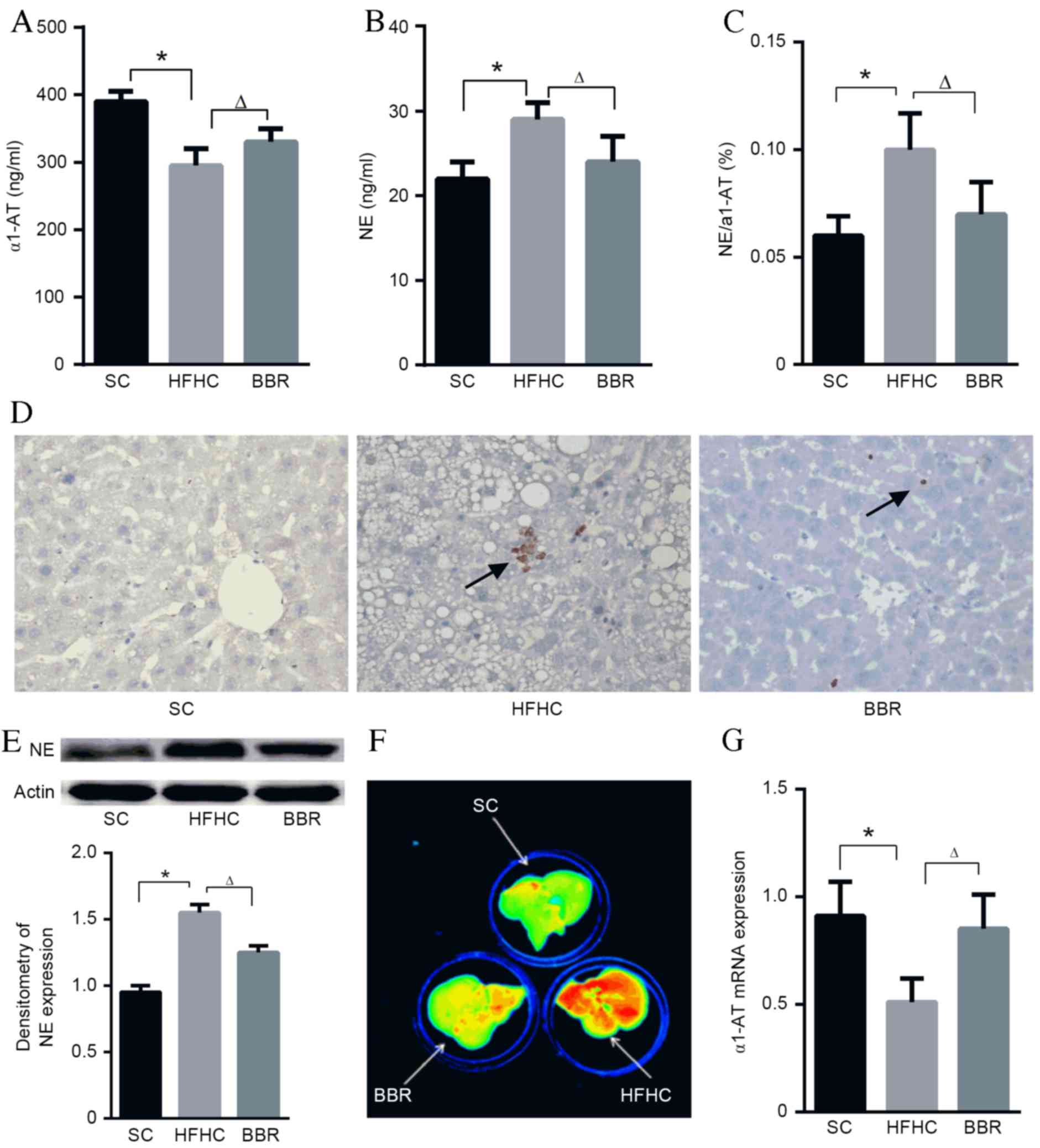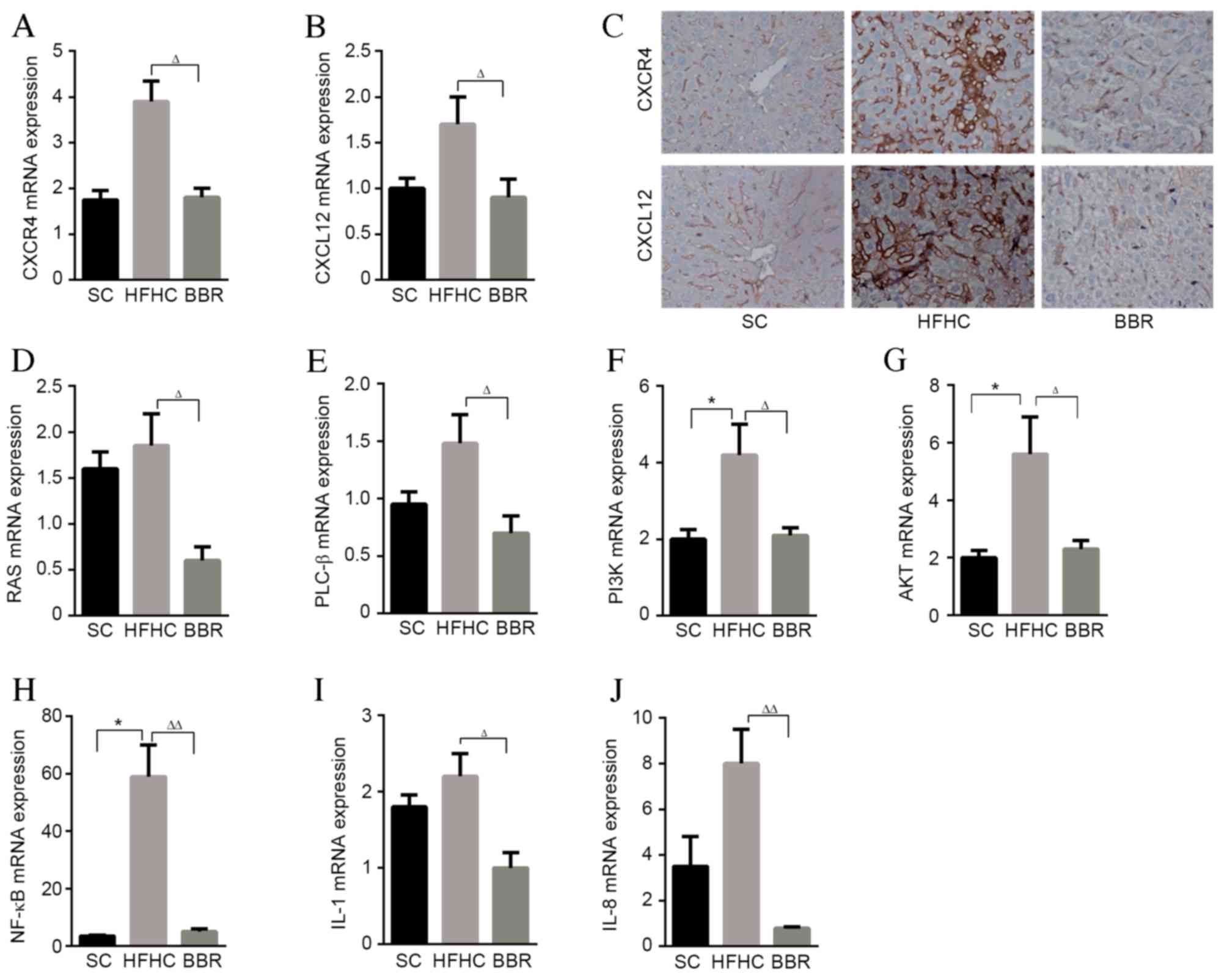|
1
|
Farrell GC, van Rooyen D, Gan L and
Chitturi S: NASH is an inflammatory disorder: Pathogenic,
prognostic and therapeutic implications. Gut Liver. 6:149–171.
2012. View Article : Google Scholar : PubMed/NCBI
|
|
2
|
Tiniakos DG, Vos MB and Brunt EM:
Nonalcoholic fatty liver disease: Pathology and pathogenesis. Annu
Rev Pathol. 5:145–171. 2010. View Article : Google Scholar : PubMed/NCBI
|
|
3
|
Gadd VL, Skoien R, Powell EE, Fagan KJ,
Winterford C, Horsfall L, Irvine K and Clouston AD: The portal
inflammatory infiltrate and ductular reaction in human nonalcoholic
fatty liver disease. Hepatology. 59:1393–1405. 2014. View Article : Google Scholar : PubMed/NCBI
|
|
4
|
Mócsai A: Diverse novel functions of
neutrophils in immunity, inflammation, and beyond. J Exp Med.
210:1283–1299. 2013. View Article : Google Scholar : PubMed/NCBI
|
|
5
|
Uchida Y, Freitas MC, Zhao D, Busuttil RW
and Kupiec-Weglinski JW: The protective function of neutrophil
elastase inhibitor in liver ischemia/reperfusion injury.
Transplantation. 89:1050–1056. 2010. View Article : Google Scholar : PubMed/NCBI
|
|
6
|
Zang S, Wang L, Ma X, Zhu G, Zhuang Z, Xun
Y, Zhao F, Yang W, Liu J, Luo Y, et al: Neutrophils play a crucial
role in the early stage of nonalcoholic steatohepatitis via
neutrophil elastase in mice. Cell Biochem Biophys. 73:479–487.
2015. View Article : Google Scholar : PubMed/NCBI
|
|
7
|
Zang S, Ma X, Zhuang Z, Liu J, Bian D, Xun
Y, Zhang Q, Zhao F, Yang W, Liu J, et al: Increased ratio of
neutrophil elastase to α1-antitrypsin is closely associated with
liver inflammation in patients with nonalcoholic steatohepatitis.
Clin Exp Pharmacol Physiol. 43:13–21. 2016. View Article : Google Scholar : PubMed/NCBI
|
|
8
|
Mansuy-Aubert V, Zhou QL, Xie X, Gong Z,
Huang JY, Khan AR, Aubert G, Candelaria K, Thomas S, Shin DJ, et
al: Imbalance between neutrophil elastase and its inhibitor
α1-antitrypsin in obesity alters insulin sensitivity, inflammation,
and energy expenditure. Cell Metab. 17:534–548. 2013. View Article : Google Scholar : PubMed/NCBI
|
|
9
|
Kulkarni SK and Dhir A: Berberine: A plant
alkaloid with therapeutic potential for central nervous system
disorders. Phytother Res. 24:317–324. 2010. View Article : Google Scholar : PubMed/NCBI
|
|
10
|
Battu SK, Repka MA, Maddineni S,
Chittiboyina AG, Avery MA and Majumdar S: Physicochemical
characterization of berberine chloride: A perspective in the
development of a solution dosage form for oral delivery. AAPS Pharm
Sci Tech. 11:1466–1475. 2010. View Article : Google Scholar
|
|
11
|
Li J, Pan Y, Kan M, Xiao X, Wang Y, Guan
F, Zhang X and Chen L: Hepatoprotective effects of berberine on
liver fibrosis via activation of AMP-activated protein kinase. Life
Sci. 98:24–30. 2014. View Article : Google Scholar : PubMed/NCBI
|
|
12
|
Sun X, Zhang X, Hu H, Lu Y, Chen J, Yasuda
K and Wang H: Berberine inhibits hepatic stellate cell
proliferation and prevents experimental liver fibrosis. Biol Pharm
Bull. 32:1533–1537. 2009. View Article : Google Scholar : PubMed/NCBI
|
|
13
|
Ye D, Li FY, Lam KS, Li H, Jia W, Wang Y,
Man K, Lo CM, Li X and Xu A: Toll-like receptor-4 mediates
obesity-induced non-alcoholic steatohepatitis through activation of
X-box binding protein-1 in mice. Gut. 61:1058–1067. 2012.
View Article : Google Scholar : PubMed/NCBI
|
|
14
|
Van Herck H, Baumans V, Brandt CJ, Boere
HA, Hesp AP, van Lith HA, Schurink M and Beynen AC: Blood sampling
from the retro-orbital plexus, the saphenous vein and the tail vein
in rats: Comparative effects on selected behavioural and blood
variables. Lab Anim. 35:131–139. 2001. View Article : Google Scholar : PubMed/NCBI
|
|
15
|
Jeon S, Park YJ and Kwon YH: Genistein
alleviates the development of nonalcoholic steatohepatitis in
ApoE(−/−) mice fed a high-fat diet. Mol Nutr Food Res. 58:830–841.
2014. View Article : Google Scholar : PubMed/NCBI
|
|
16
|
Kleiner DE, Brunt EM, Van Natta M, Behling
C, Contos MJ, Cummings OW, Ferrell LD, Liu YC, Torbenson MS,
Unalp-Arida A, et al: Design and validation of a histological
scoring system for nonalcoholic fatty liver disease. Hepatology.
41:1313–1321. 2005. View Article : Google Scholar : PubMed/NCBI
|
|
17
|
Wienken CJ, Baaske P, Duhr S and Braun D:
Thermophoretic melting curves quantify the conformation and
stability of RNA and DNA. Nucleic Acids Res. 39:e522011. View Article : Google Scholar : PubMed/NCBI
|
|
18
|
Livak KJ and Schmittgen TD: Analysis of
relative gene expression data using real-time quantitative PCR and
the 2(-Delta Delta C(T)) Method. Methods. 25:402–408. 2001.
View Article : Google Scholar : PubMed/NCBI
|
|
19
|
Elgazar-Carmon V, Rudich A, Hadad N and
Levy R: Neutrophils transiently infiltrate intra-abdominal fat
early in the course of high-fat feeding. J Lipid Res. 49:1894–1903.
2008. View Article : Google Scholar : PubMed/NCBI
|
|
20
|
Pham CT: Neutrophil serine proteases:
Specific regulators of inflammation. Nat Rev Immunol. 6:541–550.
2006. View
Article : Google Scholar : PubMed/NCBI
|
|
21
|
Boujedidi H, Robert O, Bignon A,
Cassard-Doulcier AM, Renoud ML, Gary-Gouy H, Hemon P, Tharinger H,
Prévot S, Bachelerie F, et al: CXCR4 dysfunction in non-alcoholic
steatohepatitis in mice and patients. Clin Sci (Lond). 128:257–267.
2015. View Article : Google Scholar : PubMed/NCBI
|
|
22
|
Snelgrove RJ, Jackson PL, Hardison MT,
Noerager BD, Kinloch A, Gaggar A, Shastry S, Rowe SM, Shim YM,
Hussell T and Blalock JE: A critical role for LTA4H in limiting
chronic pulmonary neutrophilic inflammation. Science. 330:90–94.
2010. View Article : Google Scholar : PubMed/NCBI
|
|
23
|
Eash KJ, Means JM, White DW and Link DC:
CXCR4 is a key regulator of neutrophil release from the bone marrow
under basal and stress granulopoiesis conditions. Blood.
113:4711–4719. 2009. View Article : Google Scholar : PubMed/NCBI
|
|
24
|
Zhang Q, Xiao X, Feng K, Wang T, Li W,
Yuan T, Sun X, Sun Q, Xiang H and Wang H: Berberine moderates
glucose and lipid metabolism through multipathway mechanism. Evid
Based Complement Alternat Med. 2011:pii:9248512011. View Article : Google Scholar
|
|
25
|
Bartelt A, Orlando P, Mele C, Ligresti A,
Toedter K, Scheja L, Heeren J and Di Marzo V: Altered
endocannabinoid signalling after a high-fat diet in Apoe(−/−) mice:
Relevance to adipose tissue inflammation, hepatic steatosis and
insulin resistance. Diabetologia. 54:2900–2910. 2011. View Article : Google Scholar : PubMed/NCBI
|
|
26
|
Talukdar S, Oh DY, Bandyopadhyay G, Li D,
Xu J, McNelis J, Lu M, Li P, Yan Q, Zhu Y, et al: Neutrophils
mediate insulin resistance in mice fed a high-fat diet through
secreted elastase. Nat Med. 18:1407–1412. 2012. View Article : Google Scholar : PubMed/NCBI
|
|
27
|
Liu H, Li J, Tillman B, Morgan TR, French
BA and French SW: TLR3/4 signaling is mediated via the NFκB-CXCR4/7
pathway in human alcoholic hepatitis and non-alcoholic
steatohepatitis which formed Mallory-Denk bodies. Exp Mol Pathol.
97:234–240. 2014. View Article : Google Scholar : PubMed/NCBI
|
|
28
|
Korkmaz B, Horwitz MS, Jenne DE and
Gauthier F: Neutrophil elastase, proteinase 3, and cathepsin G as
therapeutic targets in human diseases. Pharmacol Rev. 62:726–759.
2010. View Article : Google Scholar : PubMed/NCBI
|
|
29
|
Sharma M, Mitnala S, Vishnubhotla RK,
Mukherjee R, Reddy DN and Rao PN: The riddle of nonalcoholic fatty
liver disease: Progression from nonalcoholic fatty liver to
nonalcoholic steatohepatitis. J Clin Exp Hepatol. 5:147–158. 2015.
View Article : Google Scholar : PubMed/NCBI
|
|
30
|
Pisonero-Vaquero S, Martínez-Ferreras Á,
García-Mediavilla MV, Martínez-Flórez S, Fernández A, Benet M,
Olcoz JL, Jover R, González-Gallego J and Sánchez-Campos S:
Quercetin ameliorates dysregulation of lipid metabolism genes via
the PI3K/AKT pathway in a diet-induced mouse model of nonalcoholic
fatty liver disease. Mol Nutr Food Res. 59:879–893. 2015.
View Article : Google Scholar : PubMed/NCBI
|
|
31
|
Teicher BA and Fricker SP: CXCL12
(SDF-1)/CXCR4 pathway in cancer. Clin Cancer Res. 16:2927–2931.
2010. View Article : Google Scholar : PubMed/NCBI
|













